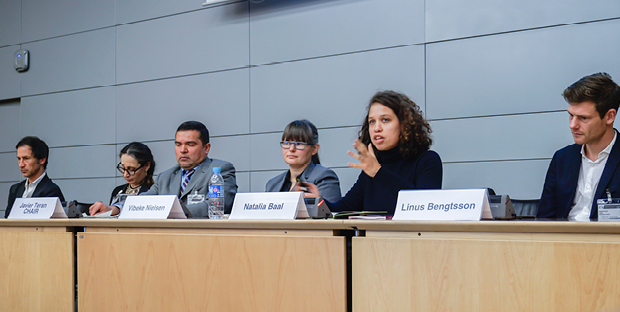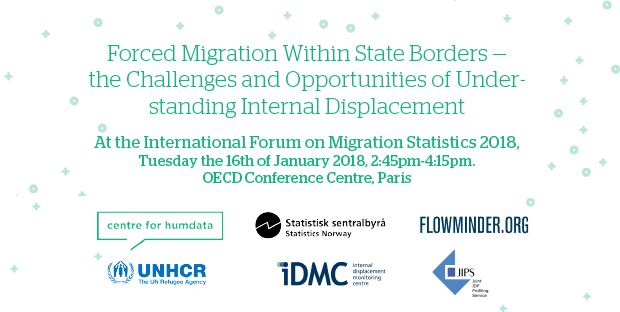To support ongoing global efforts to fill migration data gaps, the Organisation for Economic Co-operation and Development (OECD), the UN Department of Economic and Social Affairs (UN DESA) and International Organisation for Migration (IOM) jointly organised the first International Forum on Migration Statistics in Paris. A parallel session with experts from Statistics Norway, IDMC, OCHA, UNHCR, Flowminder and JIPS brought the focus to forced migration within state borders and shared the current work of the Expert Group on Refugee and IDP Statistics (EGRIS).

The panel of the parallel session on forced migration within state boarders, at the International Forum on Migration Statistics (IFMS).
“International migration is a fact of life and, if well-managed, helps our economies and societies to flourish.”
The two-day event brought together more than 400 producers, analysts and users of migration statistics. It aimed to foster exchange of views on how to improve existing practices and innovate for better measurement and understanding of global migration issues. The Forum is planned to become a regular event for continued mutual learning and cooperation among relevant stakeholders.
The parallel session “Forced migration within state borders: The challenges and opportunities of understanding internal displacement” proposed a different view point by looking more specifically at the importance of improving statistics on internal forced migration to enhance our understanding of migration as a whole at local, regional and global levels.
Even though migration and forced displacement differ due to the causes of population movements, both can happen within and across borders and many of the tools used to produce related statistics are the same. Understanding the situation of internally displaced persons (IDPs) and their relation to other population groups requires a combined development and humanitarian perspective, and quality statistics play a key role. They are vital to inform a comprehensive and effective response to displacement situations.
The need for a more systematic analysis of “when displacement ends”, as well as measuring progress towards durable solutions has furthermore been highlighted at the global level by both IDMC and the World Bank in recent reports (see here and here). Collaborative processes like profiling and similar techniques offer a concrete opportunity to address these challenges, as highlighted during the session by Natalia Baal (JIPS).
The different presentations at the parallel session laid the ground for an interesting subsequent discussion with the audience. The questions raised by participants also often come up during our profiling exercises, and are at the centre of our work within the EGRIS. Here is a snapshot of the conversations:

The panel of the parallel session brought together experts working to improve data and analysis on forced displacement within and across boarders. (Image credit: Center for Humanitarian Data / OCHA).
For a range of operational reasons, collecting data on IDPs is inherently challenging. As Kim Roberson (UNHCR) explained, collecting data in conflict affected contexts or following natural disasters, is not the easiest environment for producing quality data due to high level of insecurity and populations in flux. The humanitarian architecture, which sees a range of stakeholders coordinating response between them, has also led to challenges where different actors produce different and competing data. Justin Ginnetti (IDMC) shared experiences from the global level explaining how this fragmented data is put together to provide global estimates despite the gaps that persist.
Following the presentations, one participant suggested considering displacement not only as a national issue, but rather as a phenomena affecting a number of countries in a region. In fact, causes of displacement often cut across country borders, and finding a safe haven may be more important to displaced persons than national frontiers. Hence, taking a regional perspective on displacement may be more fruitful than distinguishing between refugees crossing borders and persons displaced within their own country.
Panellists, in particular Kim Roberson (UNHCR) and Vibeke Nielsen (Statistics Norway), emphasised the importance of enhancing in-country capacities to achieve improved data on IDPs. Trainings tailored to fit countries’ needs can help, for instance, to make better use of administrative data, or to strengthen the National Statistic Systems and hence improve the legal basis and institutional cooperation on production of statistics.
Bringing the focus of discussions to protracted displacement crises, Natalia Baal (JIPS) highlighted experiences from Somalia in using collaborative profiling techniques to produce better data and common analysis that can help to underpin joint action. Creating linkages with other panellists, Natalia also highlighted the importance of capacity building and was able to introduce the JIPS Essential Toolkit (JET), available online to support partners on the ground with practical guidance and tools.
Mobile phone technology, relocated social media data, Google searches and other forms of internet activity all offer new analytical possibilities. As a matter of fact, they are already being used in contexts ranging from tracking post-disaster displacement patterns to predicting future trends in migration flows. However, these new opportunities offered by big data also have their limitations and risks that need to be taken into account. For Linus Bengtsson from Flowminder, the major challenge is to ensure the data is representative in order to make quality statistics.
Working with over 40 governments and international experts, the Expert Group has been working on two key reports – International Recommendations on Refugee Statistics and a Technical Report on IDP Statistics. Focusing its recommendations on the inclusion of refugees and IDPs in national statistical plans and through this improving the quality and use of statistics on forced displacement, the EGRIS aims to support more predictable and comprehensive displacement response frameworks.
As Vibeke Nielsen (Statistics Norway) explained at the parallel session, implementation of the EGRIS recommendations will not only contribute to a better understanding of forced migration, but also support data needs in the international community related to reporting on and reaching the SDGs and the global compact for refugees.
The above-mentioned reports will be presented to the UN Statistical Commission in March 2018, and work is already underway on how to follow up on the recommendations in collaboration with countries.